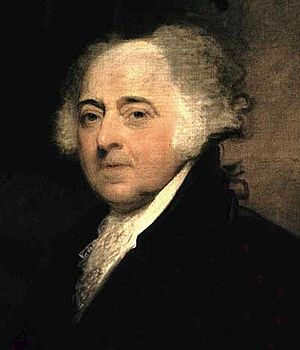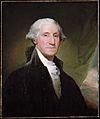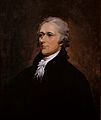John Adams facts for kids
Quick facts for kids
John Adams
|
|
|---|---|
 |
|
| 2nd President of the United States | |
| In office March 4, 1797 – March 4, 1801 |
|
| Vice President | Thomas Jefferson |
| Preceded by | George Washington |
| Succeeded by | Thomas Jefferson |
| 1st Vice President of the United States | |
| In office April 21, 1789 – March 4, 1797 |
|
| President | George Washington |
| Preceded by | Position established |
| Succeeded by | Thomas Jefferson |
| United States Minister to the Court of St. James's | |
| In office April 1, 1785 – March 30, 1788 |
|
| Appointed by | Congress of the Confederation |
| Preceded by | Position established |
| Succeeded by | Thomas Pinckney |
| United States Minister to the Netherlands | |
| In office April 19, 1782 – March 30, 1788 |
|
| Appointed by | Congress of the Confederation |
| Preceded by | Position established |
| Succeeded by | William Short |
| Delegate to the Second Continental Congress from Massachusetts |
|
| In office May 10, 1775 – June 27, 1778 |
|
| Preceded by | Position established |
| Succeeded by | Samuel Holten |
| Delegate to the First Continental Congress from Massachusetts Bay |
|
| In office September 5, 1774 – October 26, 1774 |
|
| Preceded by | Position established |
| Succeeded by | Position abolished |
| Personal details | |
| Born | October 30, 1735 Braintree, Massachusetts, U.S. |
| Died | July 4, 1826 (aged 90) Quincy, Massachusetts |
| Resting place | United First Parish Church Quincy, Massachusetts |
| Nationality | American |
| Political party | Federalist |
| Spouse | Abigail Smith |
| Children | Nabby John Quincy Susanna Charles Thomas Elizabeth (Stillborn) |
| Alma mater | Harvard University |
| Profession | Lawyer |
| Signature | |
|
|
John Adams, Jr. (October 30, 1735 – July 4, 1826) was the second President of the United States (1797–1801) and father of the sixth President, John Quincy Adams. He was also the first Vice President of the United States (1789–1797).
Adams was born in Braintree, Massachusetts. He was the son of Lt. Col. John Adams, Sr. (1691-1761) and Susanna Boylston (1708-1797). He went to Harvard College. He married Abigail Adams in 1764.
Contents
Revolution years
Adams wanted the Thirteen Colonies to be free from Great Britain. However, Adams was fair and thought every person should be treated fairly. Even though he did not want British soldiers in Boston, he was the lawyer who defended the British soldiers who were involved in the Boston Massacre.
Adams was a representative from Massachusetts during the Second Continental Congress. He helped Thomas Jefferson write the United States Declaration of Independence. During the American Revolutionary War, Adams helped make peace with Great Britain. He served in France, the Netherlands, and England as an ambassador in the 1780s.
Vice President
Adams was the first vice president under George Washington. After Washington chose not to run again, Adams won the 1796 election. Adams is thought to have been the first president to belong to a political party, but like George Washington, he thought himself above any particular party. He ran for president on the Federalist ticket. He beat Thomas Jefferson of the Democratic-Republican Party. Presidential candidates and vice-presidential candidates did not run together like they do today. Since Jefferson got the second-highest number of votes, he became vice president.
President
During his term, he resolved a conflict against France peacefully. He also passed the Alien and Sedition Acts which made it illegal to say bad things about the government. Many people did not like those acts because they felt they took away their freedom of speech. Adams was not re-elected president and lost to Thomas Jefferson. The Federalist Party was not as popular as it was when Adams was elected. One of his last acts as president was to make John Marshall the Chief Justice of the United States. This made sure that the Federalist Party would still be important.
Of the first five U.S. presidents, Adams was the only one who did not own slaves. He was also the only one to be from New England.
Death
Adams died on July 4, 1826 of heart failure. This was the same day that Thomas Jefferson died, and was also exactly 50 years after the Declaration of Independence was signed in 1776.
John Adams quotes
- "From all that I had read of History and Government, of human Life and manners, I had drawn this Conclusion, that the manners of Women were the most infallible Barometer, to ascertain the degree of morality and virtue in a nation. The Jews, the Greeks, the Romans, the Swiss, the Dutch, all lost their public Spirit, their Republican Principles and habits, and their Republican Forms of Government, when they lost the Modesty and Domestic Virtues of their Women."
- “If conscience disapproves, the loudest applauses of the world are of little value.”
- “Defeat appears to me preferable to total inaction.”
- “Because power corrupts, society’s demands for moral authority and character increase as the importance of the position increases.”
- “Liberty cannot be preserved without a general knowledge among the people.”
Interesting facts about John Adams
- John Adams went to Harvard University and became a fair lawyer.
- He represented Massachusetts during the Second Continental Congress.
- John Adams helped Thomas Jefferson write the Declaration of Independence.
- John Adams was the first Vice President of the United States.
- He was elected to be the second President of the United States, winning against Thomas Jefferson.
- When Adams chose to run again, he lost to Thomas Jefferson.
- John Adams and Thomas Jefferson died on the same day - July 4, 1826 - on the 50th anniversary of the Declaration of Independence.
- John Quincy Adams, the sixth president of the United States, was the son of John and Abigail Adams.
Legacy
Historical reputation
Adams strongly felt that he would be forgotten and underappreciated by history. Because of that, he sometimes envied and verbally attacked other Founders. Historian Edmund Morgan argues, "Adams was ridiculously vain, absurdly jealous, embarrassingly hungry for compliments. But no man ever served his country more selflessly."
Historian George Herring argues that Adams was the most independent-minded of the Founders. He was often described as "prickly". Stubbornness was seen as one of his defining traits. Most historians applaud him for avoiding an all-out war with France during his presidency. His signing of the Alien and Sedition Acts is almost always condemned.
In the 21st century, Adams remains less well known than many of America's other Founding Fathers, in accordance with his predictions.
In 2001, David McCullough published a biography of the president entitled John Adams. In 2008, a miniseries was released based on the McCullough biography, featuring Paul Giamatti as Adams.
In memoriam
Adams is commemorated as the namesake of various counties, buildings, and other items. One example is the John Adams Building of the Library of Congress, an institution whose existence Adams had signed into law.
While Adams is honored on the Memorial to the 56 Signers of the Declaration of Independence in Washington D.C., he does not have an individual monument dedicated to him in the city. Although a family inclusive Adams Memorial was authorized in 2001, it awaits funding.
Images for kids
-
Adams's birthplace now in Quincy, Massachusetts
-
John Trumbull's Declaration of Independence depicts the Committee of Five presenting its draft to Congress. Adams is depicted in the center with his hand on his hip.
-
The Assembly Room in Philadelphia's Independence Hall, where the Second Continental Congress adopted the Declaration of Independence
-
Adams frequently clashed with Benjamin Franklin over how to manage French relations.
-
Treaty of Paris by Benjamin West (Adams in front).
-
Adams – 1785 Mather Brown Portrait
-
Portrait of Adams by John Trumbull, 1793
-
Portrait of George Washington by Gilbert Stuart, 1795. Washington rarely consulted Vice President Adams, who often felt marginalized and overshadowed by Washington's prestige.
-
President's House, Philadelphia. Adams occupied this Philadelphia mansion from March 1797 to May 1800.
-
John Adams, c. 1816, by Samuel Morse (Brooklyn Museum)
-
Tombs of John and Abigail Adams (far) and John Quincy and Louisa Adams (near), in family crypt at United First Parish Church
See also
 In Spanish: John Adams para niños
In Spanish: John Adams para niños

















